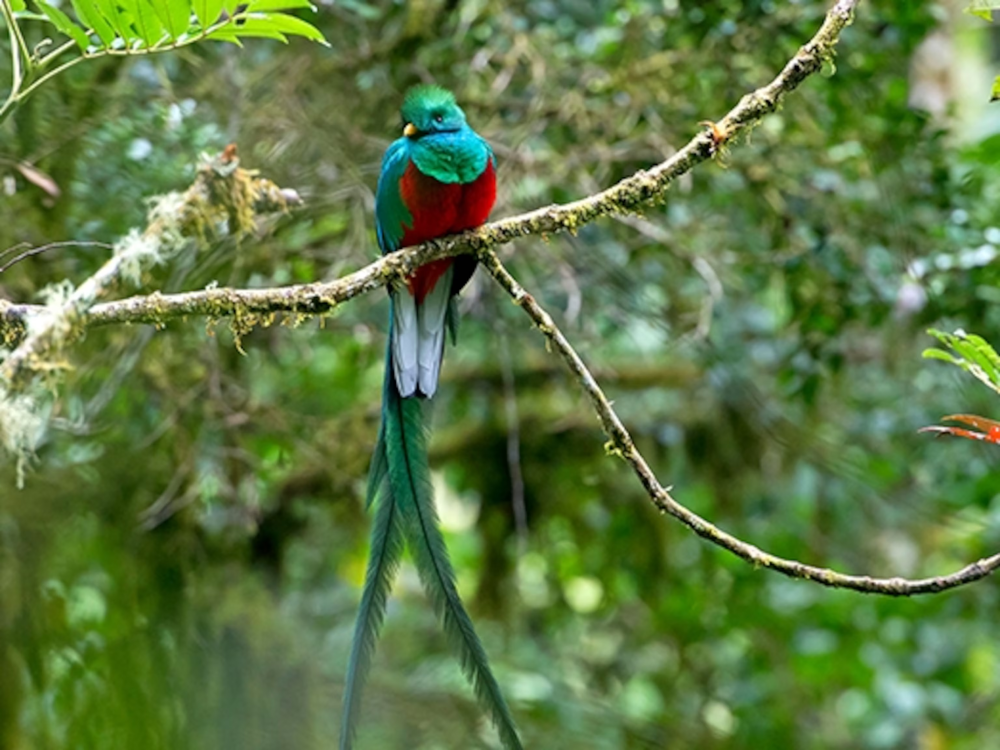Physical Characteristics of Resplendent Quetzal
The Resplendent Quetzal is popular for its extraordinary appearance. The males are especially striking, boasting iridescent green plumage that can appear to shimmer from gold to blue, depending on the light. They also feature a bright red breast and belly, along with a distinctive helmet-like crest on their heads. The most iconic aspect of the male quetzal is its long tail feathers, which can extend up to 1 meter (3 feet) beyond the body, creating a spectacular display during flight. Females, while less flamboyant, are also beautiful, with a more subdued palette of green and red, and shorter tail feathers.
These birds measure about 36-40 cm (14-16 inches) in length, not including the male’s elongated tail feathers. Both males and females have a pale yellow bill and striking, large eyes that add to their majestic appearance.
Habitat and Distribution
Resplendent Quetzals primarily live in the cloud forests of Central America, spanning from southern Mexico to western Panama. These forests, typically situated at altitudes between 1,000 and 3,000 meters (3,300-9,800 feet), provide the cool, moist environment that quetzals prefer. The dense canopy and abundant epiphytes, such as mosses and bromeliads, create a perfect habitat for these birds, offering ample food sources and nesting sites.
The preservation of these cloud forests is crucial for the survival of the quetzals. Unfortunately, habitat loss due to deforestation and climate change poses a significant threat to their populations.
Diet and Feeding Behavior of Resplendent Quetzal
Resplendent Quetzals primarily feed on fruits, with a particular preference for the fruits of wild avocado trees (Lauraceae family). They play a crucial role in their ecosystem as seed dispersers, aiding the regeneration of the forest. In addition to fruits, quetzals consume insects, small frogs, and lizards, especially during the breeding season when they require extra protein for their young.
These birds are adept at foraging in the dense forest canopy. Their strong, broad bills are well-suited for plucking fruits, and their agility allows them to maneuver through the thick vegetation with ease.
Reproduction and Life Cycle
The breeding season for Resplendent Quetzals typically occurs between March and June, coinciding with the onset of the rainy season. Males perform elaborate courtship displays, showcasing their long tail feathers and vibrant plumage to attract females. These displays often involve a combination of aerial acrobatics and vocalizations.
Quetzals are cavity nesters, typically choosing to nest in decaying trees or in the natural cavities of large, mature trees. Both the male and female participate in excavating the nest, which is usually placed high above the ground to protect against predators. The female lays two eggs, which both parents take turns incubating for about 17-19 days.
Once hatched, the chicks are altricial, meaning they are born naked and helpless. Both parents are actively involved in feeding and caring for the chicks, bringing them a diet rich in fruits and insects. The chicks fledge after approximately three weeks, but they remain dependent on their parents for some time as they learn to forage and fly.

Cultural Significance of Resplendent Quetzal
The Resplendent Quetzal holds immense cultural significance, especially in Mesoamerican civilizations. The bird was revered by the ancient Maya and Aztec civilizations, symbolizing freedom and wealth. Its vibrant feathers were highly prized and used in royal garments and ceremonial headdresses.
The name “quetzal” itself is derived from the Nahuatl word “quetzalli,” meaning “precious” or “sacred.” In Mayan mythology, the quetzal has associations with Quetzalcoatl, the feathered serpent god, symbolizing the union of earth and sky. The bird was also seen as an embodiment of the spirit of the forest and a symbol of liberty due to its elusive nature.
Today, the quetzal is the national bird of Guatemala and features prominently on the country’s flag and coat of arms. It is also the namesake of the Guatemalan currency, the quetzal, further underscoring its importance to the nation’s cultural heritage.
Conservation Status
Despite its revered status, the Resplendent Quetzal faces numerous threats that have led to its classification as Near Threatened by the International Union for Conservation of Nature (IUCN). Habitat destruction, primarily due to deforestation for agriculture and logging, poses the greatest risk to quetzal populations. The fragmentation of cloud forests limits the availability of suitable nesting sites and disrupts the delicate ecological balance these birds depend on.
Climate change also poses a significant threat, as alterations in temperature and precipitation patterns can affect the cloud forest ecosystem. These changes can lead to shifts in the distribution of quetzal populations and impact the availability of food sources.
Conservation efforts are crucial to ensure the survival of the Resplendent Quetzal. Protected areas, such as national parks and reserves, play a vital role in preserving their habitat. Ecotourism initiatives also contribute to conservation by raising awareness and generating funding for protection efforts. Sustainable agricultural practices and reforestation projects are essential for mitigating habitat loss and ensuring the long-term survival of these magnificent birds.
Conclusion
The Resplendent Quetzal is not just a bird; it is a symbol of the rich natural and cultural heritage of Central America. Its dazzling beauty, ecological importance, and profound cultural significance make it a true gem of the cloud forests. Ensuring the conservation of this species and its habitat is not only crucial for maintaining biodiversity but also for preserving a symbol that has inspired awe and reverence for centuries. Through concerted conservation efforts and sustainable practices, we can hope to see the Resplendent Quetzal continue to thrive in the wild, gracing the forests with its ethereal presence for generations to come.









